小学英语绘本《Where is my mom》课件
- 格式:ppt
- 大小:13.27 MB
- 文档页数:53
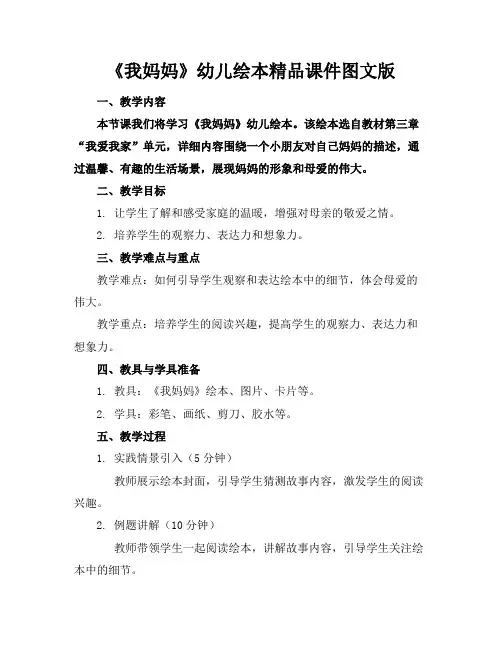
《我妈妈》幼儿绘本精品课件图文版一、教学内容本节课我们将学习《我妈妈》幼儿绘本。
该绘本选自教材第三章“我爱我家”单元,详细内容围绕一个小朋友对自己妈妈的描述,通过温馨、有趣的生活场景,展现妈妈的形象和母爱的伟大。
二、教学目标1. 让学生了解和感受家庭的温暖,增强对母亲的敬爱之情。
2. 培养学生的观察力、表达力和想象力。
三、教学难点与重点教学难点:如何引导学生观察和表达绘本中的细节,体会母爱的伟大。
教学重点:培养学生的阅读兴趣,提高学生的观察力、表达力和想象力。
四、教具与学具准备1. 教具:《我妈妈》绘本、图片、卡片等。
2. 学具:彩笔、画纸、剪刀、胶水等。
五、教学过程1. 实践情景引入(5分钟)教师展示绘本封面,引导学生猜测故事内容,激发学生的阅读兴趣。
2. 例题讲解(10分钟)教师带领学生一起阅读绘本,讲解故事内容,引导学生关注绘本中的细节。
3. 随堂练习(10分钟)学生分小组讨论,用彩笔画出自己心中的妈妈形象,并分享给其他同学。
4. 互动环节(10分钟)教师邀请学生扮演绘本中的角色,进行角色扮演,让学生更好地体会故事情感。
六、板书设计1. 《我妈妈》2. 内容:绘本故事梗概、妈妈形象、母爱主题七、作业设计1. 作业题目:画一画你的妈妈,并写一段话描述你对妈妈的爱。
2. 答案示例:我的妈妈很温柔,她总是关心我。
我画妈妈的时候,特意画了一颗爱心,代表我对妈妈的爱。
八、课后反思及拓展延伸1. 课后反思:本节课学生的参与度较高,但在引导学生观察绘本细节方面还需加强。
2. 拓展延伸:鼓励学生回家后,与家人分享绘本故事,感受家庭的温暖,并将所学内容运用到日常生活中。
重点和难点解析1. 引导学生观察绘本细节2. 培养学生的观察力、表达力和想象力3. 作业设计中的绘画与文字描述结合一、引导学生观察绘本细节1. 角色形象:引导学生观察绘本中妈妈的外貌、表情和动作,通过这些细节描绘出妈妈的特点。
2. 情感表达:关注绘本中小朋友对妈妈的爱和敬仰之情,通过语言、表情和场景来体现。
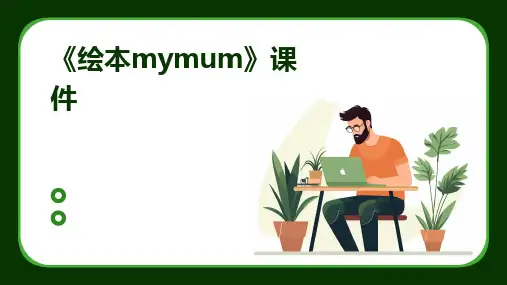
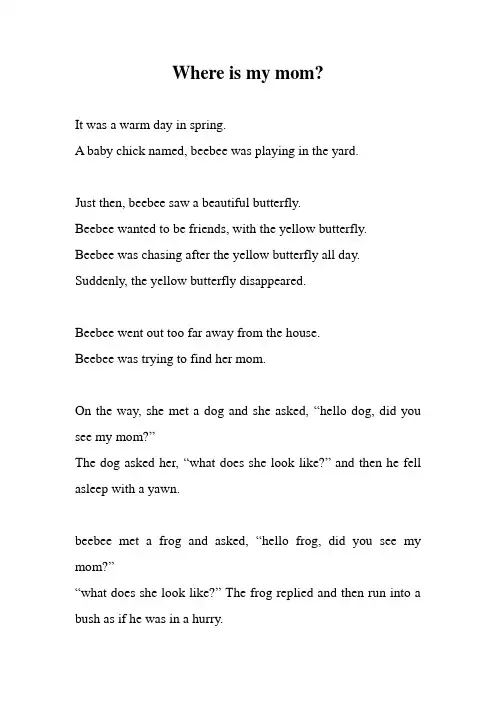
Where is my mom?It was a warm day in spring.A baby chick named, beebee was playing in the yard.Just then, beebee saw a beautiful butterfly.Beebee wanted to be friends, with the yellow butterfly. Beebee was chasing after the yellow butterfly all day. Suddenly, the yellow butterfly disappeared.Beebee went out too far away from the house.Beebee was trying to find her mom.On the way, she met a dog and she asked, “hello dog, did you see my mom?”The dog asked her, “what does she look like?” and then he fell asleep with a yawn.beebee met a frog and asked, “hello frog, did you see my mom?”“what does she look like?” The frog replied and then run into a bush as if he was in a hurry.Beebee met a cow and asked, “hello, did you see my mom?”The cow replied, “oh well, what does she look like?”The cow seemed as if she didn’t know her mom.When the night came, beebee hide herself under a pumpkin tree. She was very hungry and scared of the dark.“mom, I miss you.” Said beebee and she fell asleep.Next morning, beebee woke up by the animal’s crying.But still her mom wasn’t there.“oh dear, where is my mother?“coock-a-doodle-doo! coock-a-doodle-doo!”It was beebee’s mother.Mommy! Said beebee.Finally, beebee found her mother.。

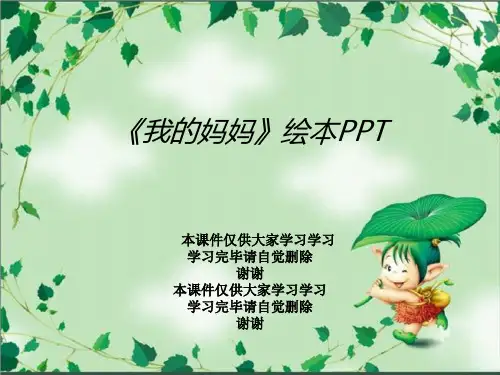
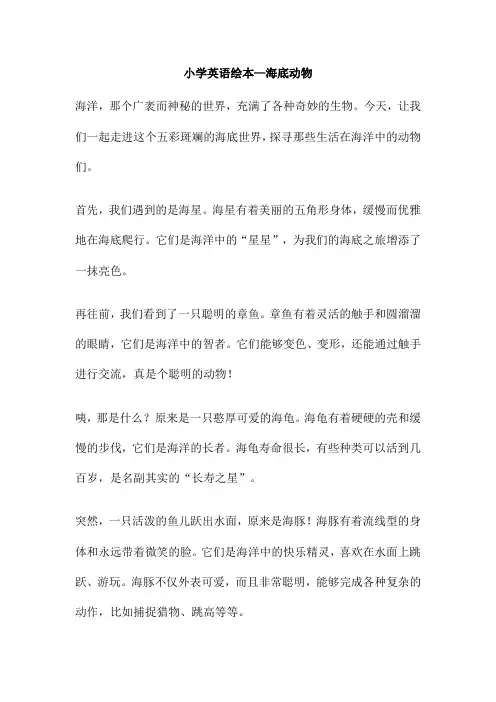
小学英语绘本—海底动物海洋,那个广袤而神秘的世界,充满了各种奇妙的生物。
今天,让我们一起走进这个五彩斑斓的海底世界,探寻那些生活在海洋中的动物们。
首先,我们遇到的是海星。
海星有着美丽的五角形身体,缓慢而优雅地在海底爬行。
它们是海洋中的“星星”,为我们的海底之旅增添了一抹亮色。
再往前,我们看到了一只聪明的章鱼。
章鱼有着灵活的触手和圆溜溜的眼睛,它们是海洋中的智者。
它们能够变色、变形,还能通过触手进行交流,真是个聪明的动物!咦,那是什么?原来是一只憨厚可爱的海龟。
海龟有着硬硬的壳和缓慢的步伐,它们是海洋的长者。
海龟寿命很长,有些种类可以活到几百岁,是名副其实的“长寿之星”。
突然,一只活泼的鱼儿跃出水面,原来是海豚!海豚有着流线型的身体和永远带着微笑的脸。
它们是海洋中的快乐精灵,喜欢在水面上跳跃、游玩。
海豚不仅外表可爱,而且非常聪明,能够完成各种复杂的动作,比如捕捉猎物、跳高等等。
最后,我们遇到了一只勇敢的鲨鱼。
鲨鱼有着锋利的牙齿和强壮的身体,是海洋中的勇士。
虽然鲨鱼有些可怕,但它们是海洋食物链的重要一环,保护着海洋生态的平衡。
在这个奇妙的海底世界中,我们遇到了各种奇特的动物。
它们每一个都有自己独特的生活方式和特点,让我们的海底之旅充满了惊喜和好奇。
希望通过这本书,大家能更加了解海洋动物,更加热爱我们的地球家园。
小学英语绘本《Where is my mom》课件一、引言在为小学生们教授英语时,我们常常需要借助一些生动有趣的教学工具来激发他们的学习兴趣。
其中,英语绘本以其精美的插图和浅显易懂的故事内容深受孩子们的喜爱。
今天,我将为大家介绍一本名为《Where is my mom》的小学英语绘本课件。
二、绘本简介《Where is my mom》是一本适合小学生阅读的英语绘本,它的故事内容温馨而富有童趣。
故事讲述了一个小鸭子在寻找妈妈的旅程中,遇到了各种小动物,并借助它们的帮助最终找到了妈妈。
通过这个故事,孩子们不仅可以学习到一些基础的英语单词和句型,还可以了解到互助和亲情的重要性。

英语绘本mymum课件•Introduction and Background of Picture Books•Text interpretation and appreciation•Exploration of Illustration Art in Picture Books•Theme ideas and educational value mining•Cross cultural comparison and extension•Design and implementation suggestions for practical activitiesIntroduction and Background of Picture BooksOverview of Picture Book "My Mum""My Mum" is an English picture book with the theme ofpraising mothers, showcasing a mother who is bothordinary and special from a child's perspective.In the picture book, the author uses simple and vividlanguage and pictures to depict various images of themother and daily life, expressing the child's deep loveand admiration for the mother.Author Anthony Browne is a famous British children's picture book writer and illustrator, known for his surrealistic style in his works, adept at using symbols and metaphors to express themes."My Mum" is one of Anthony Brown's representative works, inspired by his personal childhood experiences and deep feelings for his mother. Through this picture book, he hopes to guide children to cherish and appreciatematernal love more.Author and creative backgroundThe text in the picture book is concise and clear, rhymes and has a sense of rhythm. It reads aloudand is easy for children to accept and love. At the same time, through vivid pictures and vivid metaphors, help children better understand the content of the text.The picture book adopts a surrealistic style, combining rich imagination and exaggeratedexpression techniques to create a dreamy and infectious visual effect.The screen has bright and vibrant colors, using a large number of contrasting and complementarycolors, making the entire picture book full of vitality and tension.Picture book style and characteristicsText interpretation and appreciation03Plot twistWhen the protagonist encounters difficulties or challenges, his mother provides encouragement and support.01Story openingIntroduce the daily life of the protagonist and mother, showcasing the intimate mother son relationship.02Emotional expressionBy depicting the details of the mother taking care of the protagonist, express gratitude and love for the mother.Story climaxThe protagonist overcomes difficulties and achieves success with the help of his mother.ConclusionEmphasizing the deep emotional connection between mother and son, as well as the significant influence of the mother on the protagonist's growth.Character image analysisMomGentle, considerate, strong, and wise, she is the protagonist's guide andsupporter.The protagonistBrave, persevering, kind, and grateful, gradually growing up under the care of hismother.Other charactersAccording to the needs of the story plot, some auxiliary characters can be set up,such as the protagonist's friends, teachers, etc., to enrich the story content andcharacter images.Language characteristics and expression skills•Vivid Description: Using vivid vocabulary and techniques to enablereaders to deeply experience the story context and characteremotions.•Emotional rendering: By using sentence structures such as exclamationand rhetorical questions, the expression of emotions is enhanced,making readers resonate.•Concise and clear: The language is concise and clear, avoidingexcessive embellishments and complex sentence structures, making iteasy for readers to understand and accept.•Repetition and parallelism: Using rhetorical devices such as repetitionand parallelism to enhance the rhythm and infectiousness of language,leaving a deep impression on readers.Exploration of Illustration Art in Picture BooksAnalysis of illustration style and techniquesWarm and Soft TonesPicture books use warm and soft tones to create a warm atmosphere between parents and children,allowing readers to feel the warmth of home while reading.Vivid character imagesThe figures in the illustrations are lifelike, expressing their emotions and personalities through delicatelines and colors, making it easier for readers to resonate.Rich scene descriptionThe scenes in picture books are rich and colorful, and through delicate brushstrokes and colorrendering, readers are brought into an imaginative world.Illustrations and textcomplement each otherIllustrations and text in picture books complement each other to build a complete story world.Illustrations showcase the story plot through visualimagery, while texts enrich the story's meaningthrough language descriptions.要点一要点二The interpretation and extension of illustrations to text Illustrations not only explain the content of the text, but also extend and expand the text. Through the depiction of illustrations, readers can gain a deeper understanding of the theme and significance of the story.Exploration of the Relationship betweenIllustrations and TextThe role of illustrations in story expressionEnhance the fun of the storyvivid and interesting illustrations can increase the fun of the story, attractreaders' attention, and stimulate their reading interest.Help readers understand the story plotIllustrations showcase the story plot through intuitive visual imagery, helpingreaders better understand the development of the story and the relationshipsbetween characters.Conveying the theme and emotions of the storyIllustrations convey the theme and emotions of the story through visualelements such as color and lines, allowing readers to resonate and emotionalresonance during the reading process.Theme ideas and educational value miningElaborate on the theme and ideasMotherly selflessnessPicture books depict the small sacrifices made by mothers in their daily lives, showcasing the greatness and selflessness of maternal love, and inspiring children's gratitude towards their mothers.The multiple roles of a motherThe mother in the picture book is not only the caregiver of the child, but also the guide and supporter of the child's growth process, reflecting the important role of a mother in the child's growth process.Through reading English picture books, children can learn English vocabulary and expressions in a relaxed and enjoyable atmosphere, and improve their English language abilities.The story plot and characterimages in picture books helpguide children to understand andfeel various emotions, cultivatetheir emotional expression abilityand emotional intelligence.Through the portrayal ofmothers and the portrayal ofstorylines, picture books conveyexcellent qualities such askindness, bravery, and resilienceto children, which helps tocultivate their moral character.Language learning Emotionalcultivation Moral EducationReflection of educational valueInspiration for children's growthGratitude01By reading picture books, children can deeply appreciate thegreatness and selflessness of maternal love, and learn to begrateful and cherish the efforts of those around them.Role identification02The image of mothers in picture books can help childrendevelop role identification, helping them better understand andaccept their gender and family roles.Self growth03By observing and imitating the behavior and qualities ofmothers, children can learn how to face challenges anddifficulties in life, promoting their own growth and development.Cross cultural comparison and extensionComparison of Differences in Family Concepts between the East and the West•Differences in family structure: Chinese families usually attachimportance to the concept of a large family, emphasizing family andkinship relationships; Western families place more emphasis on thenuclear family, which is a small family composed of parents andchildren.•Differences in parent-child relationships: Chinese families emphasizethe authority of parents and the obedience of children, emphasizingfilial piety; Western families place greater emphasis on equality andrespect, encouraging children to express themselves.•Differences in educational concepts: Chinese families generally attachgreat importance to academic performance and talent development,emphasizing the comprehensive development of their children;Western families place greater emphasis on their children'spersonalities and interests, encouraging them to explore freely.Exploring the expression of maternal love in different cultural backgrounds•Differences in expression methods: Chinese mothers usually expressmaternal love by taking care of their children's daily life, payingattention to academic performance, and other means; Westernmothers place greater emphasis on cultivating their children'sindependence and autonomy, encouraging them to explorethemselves.•Expectation difference: Chinese mothers often have high expectationsfor their children, hoping that their children can stand out; Westernmothers place greater emphasis on their children's happiness andmental health, encouraging them to pursue their dreams.•Differences in communication methods: Chinese mothers pay moreattention to listening and understanding when communicating withtheir children, emphasizing emotional communication; Westernmothers place more emphasis on guidance and inspiration,encouraging their children to express their thoughts and feelings.Introduce different culturesIntroduce children to the cultures and customs of different countries throughvarious forms such as picture books, stories, and movies, helping them understand the diversity of the world.Respect cultural differencesEducate children to respect values and lifestyles from different culturalbackgrounds, and avoid stereotypical impressions and discrimination against them.Cultivate cross-cultural communication skillsEncourage children to learn foreign languages and participate in internationalcommunication activities, improve their cross-cultural communication skills and global perspectives.Guide children to understand and respect multiculturalismDesign and implementation suggestions for practical activities•Activity objective: To organize a reading promotion activity for the English picture book "My Mum" to stimulate children's interest in reading, improve their English reading ability, and enhance emotional communication between mother and child/mother daughter.Activity contentReading guide: Stimulate children's interest and curiosity in picture books through a brief introduction and cover interpretation.Reading and explanation: Teachers or parents lead children to read picture books together, explaining the story plot and key vocabulary while reading.Interactive discussionEncourage children to share their understanding and feelings about the story, and raise their own questions or perspectives.Activity formatIt can be conducted in the form of group activities, class activities, or parent-child activities.reading activities•Preparation for co reading: Parents should familiarize themselves with the content of the picture book in advance, understand the background and plot of the story, and prepare for co reading.reading activitiesCo reading processCreate a reading atmosphere: Choose a quiet and comfortable environmentto let children feel the pleasure and relaxation of reading.Interactive reading: Parents can ask questions while reading, guiding theirchildren to participate in understanding and thinking about the story.Implementation suggestions for parent-child reading activitiesEmotional communicationThrough co reading, it enhances emotional communication between parents and children,allowing children to feel the companionship and care of their parents.Post reading activitiesEncourage children to retell stories or express their thoughts and feelings, and also engagein related handicraft or painting activities.books•Preparation for creation: Provide painting materials and paper for children to choose their favorite colors and brushes.booksThe creative processGuide imagination: Encourage children to imagine what their mother looks like,what her characteristics and strengths are.Free Creation: Allow children to freely express themselves and depict their mother'simage in their own way.booksText assistanceFor older children, you can guidethem to add some simple Englishdescriptions or titles.Work DisplayShow the children's works,allowing them to appreciate andcommunicate with each other,improving their confidence andexpression ability.THANKS。
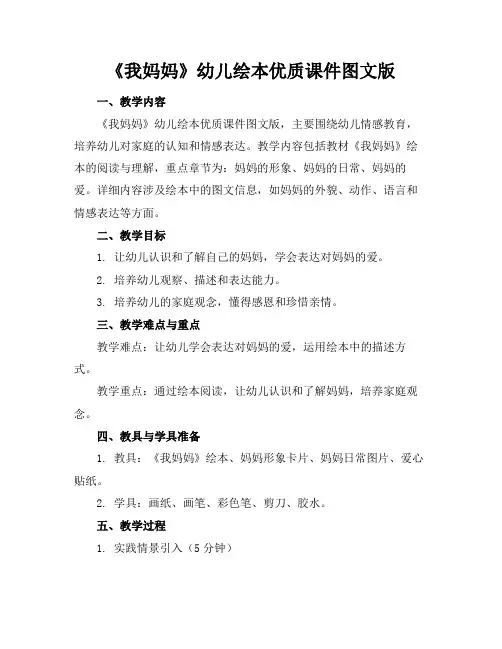
《我妈妈》幼儿绘本优质课件图文版一、教学内容《我妈妈》幼儿绘本优质课件图文版,主要围绕幼儿情感教育,培养幼儿对家庭的认知和情感表达。
教学内容包括教材《我妈妈》绘本的阅读与理解,重点章节为:妈妈的形象、妈妈的日常、妈妈的爱。
详细内容涉及绘本中的图文信息,如妈妈的外貌、动作、语言和情感表达等方面。
二、教学目标1. 让幼儿认识和了解自己的妈妈,学会表达对妈妈的爱。
2. 培养幼儿观察、描述和表达能力。
3. 培养幼儿的家庭观念,懂得感恩和珍惜亲情。
三、教学难点与重点教学难点:让幼儿学会表达对妈妈的爱,运用绘本中的描述方式。
教学重点:通过绘本阅读,让幼儿认识和了解妈妈,培养家庭观念。
四、教具与学具准备1. 教具:《我妈妈》绘本、妈妈形象卡片、妈妈日常图片、爱心贴纸。
2. 学具:画纸、画笔、彩色笔、剪刀、胶水。
五、教学过程1. 实践情景引入(5分钟)教师展示妈妈的形象卡片,引导幼儿观察并说出自己妈妈的特点。
邀请幼儿分享自己与妈妈之间的趣事,营造温馨的氛围。
2. 绘本阅读与理解(10分钟)教师带领幼儿阅读《我妈妈》绘本,讲解绘本中的内容。
针对妈妈的形象、日常和爱三个方面,引导幼儿观察、描述和表达。
3. 例题讲解与随堂练习(10分钟)教师选取绘本中的典型描述,如“妈妈像蝴蝶一样美丽”,引导幼儿模仿描述。
邀请幼儿用画笔、彩色笔等学具,绘制自己心中的妈妈形象。
4. 互动环节(5分钟)教师组织幼儿用爱心贴纸,为妈妈制作贺卡,表达对妈妈的爱。
邀请幼儿分享自己制作的贺卡,互相鼓励、点赞。
教师进行情感升华,让幼儿懂得感恩和珍惜亲情。
六、板书设计1. 妈妈的形象:美丽、温柔、善良2. 妈妈的日常:照顾我、陪我玩耍、为我付出3. 妈妈的爱:无私、伟大、永恒七、作业设计1. 作业题目:画出自己心中的妈妈,并用一句话描述妈妈的特点。
答案示例:我妈妈像太阳一样温暖,她总是关心我、照顾我。
2. 作业题目:给妈妈写一封信,表达对妈妈的爱和感激之情。


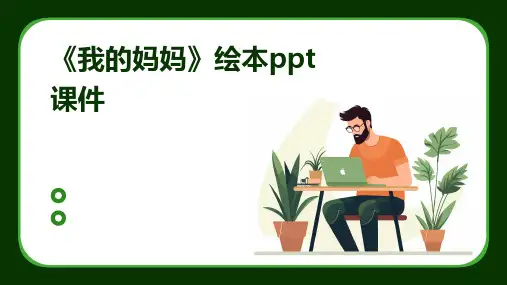
儿童绘本故事《我妈妈》图文课件一、教学内容本节课选自教材《儿童绘本阅读与表达》第三单元“亲情”章节,主要内容为《我妈妈》绘本故事。
该绘本通过生动的图文描述,展示了妈妈在孩子心中的形象,以及妈妈在日常生活中的关爱与付出。
二、教学目标1. 让学生了解绘本的基本结构,提高学生的阅读兴趣和表达能力。
2. 培养学生热爱母亲、尊敬母亲的美好情感,增强家庭观念。
3. 培养学生的观察力、想象力和创造力,提高审美素养。
三、教学难点与重点1. 教学难点:如何引导学生通过观察、思考和表达,深入理解绘本故事中母亲的形象和情感。
2. 教学重点:培养学生热爱母亲、尊敬母亲的美好情感,提高学生的阅读和表达能力。
四、教具与学具准备1. 教具:PPT课件、绘本《我妈妈》、挂图、黑板、粉笔。
2. 学具:画纸、彩笔、剪刀、胶棒等。
五、教学过程1. 导入:通过展示一组亲子互动的图片,引导学生关注亲情,为新课学习营造氛围。
2. 新课呈现:教师带领学生共同阅读绘本《我妈妈》,引导学生关注绘本中的图文细节,理解母亲的形象和情感。
3. 例题讲解:针对绘本中的某一情节,进行详细讲解,分析母亲的形象特点,培养学生的观察力和想象力。
4. 随堂练习:学生分组讨论,用画笔和文字表达自己心中的妈妈形象,并进行分享。
6. 课堂小结:对本节课的学习内容进行回顾,强调热爱母亲、尊敬母亲的重要性。
六、板书设计1. 《我妈妈》2. 内容:母亲的形象特点母亲的关爱与付出热爱母亲、尊敬母亲七、作业设计1. 作业题目:以“我的妈妈”为主题,画一幅画或写一篇文章,表达对妈妈的热爱和尊敬。
2. 答案要求:画作或文章需体现出妈妈的特点和对自己的关爱,内容真实、情感真挚。
八、课后反思及拓展延伸1. 课后反思:教师针对本节课的教学效果进行反思,调整教学策略,以提高学生的阅读和表达能力。
2. 拓展延伸:鼓励学生课后与家长共同阅读其他亲情类绘本,分享阅读心得,增进亲子关系。
同时,组织学生参加“我心中的妈妈”主题班会,展示学生的作业成果,提高学生的表达能力。
Where is my mom?It was a warm day in spring.A baby chick named, beebee was playing in the yard.Just then, beebee saw a beautiful butterfly.Beebee wanted to be friends, with the yellow butterfly. Beebee was chasing after the yellow butterfly all day. Suddenly, the yellow butterfly disappeared.Beebee went out too far away from the house.Beebee was trying to find her mom.On the way, she met a dog and she asked, “hello dog, did you see my mom?”The dog asked her, “what does she look like?” and then he fell asleep with a yawn.beebee met a frog and asked, “hello frog, did you see my mom?”“what does she look like?” The frog replied and then run into a bush as if he was in a hurry.Beebee met a cow and asked, “hello, did you see my mom?”The cow replied, “oh well, what does she look like?”The cow seemed as if she didn’t know her mom.When the night came, beebee hide herself under a pumpkin tree. She was very hungry and scared of the dark.“mom, I miss you.” Said beebee and she fell asleep.Next morning, beebee woke up by the animal’s crying.But still her mom wasn’t there.“oh dear, where is my mother?“coock-a-doodle-doo! coock-a-doodle-doo!”It was beebee’s mother.Mommy! Said beebee.Finally, beebee found her mother.。